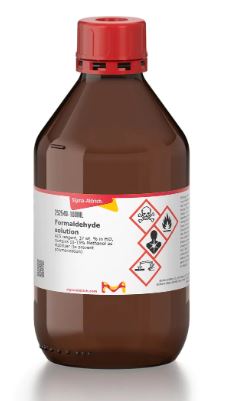FORMALDEHYDE (formol), 37%, 1 l, bot.
Valid Article
FORMALDEHYDE (formol), 37%
Definition
Preservative used for biological products (biopsies, anatomical parts, in certain cases for stools), as well as for the formaldehyde concentration technique of parasites in stools.
In TB culture laboratories that performs MGIT liquid cultures it is used for the preparation of the formol-milk suspension.
Synonym
formol, formalin
Specifications
Technical specifications
- Colorless liquid
- Aqueous solution: 35 - 40%
- Formula: CH2O (HCHO)
- Stabilised with 10 to 15% of methanol
- Mixture
- formaldehyde (>=25% -<50% ) CAS N°50-00-0
- methanol (>=10% -<20% ) CAS N° 67-56-1
Packaging & Labelling
1 litre glass or plastic bottle or 20 ml vial
Transport Dangerous Goods
- UN2209
- Class: 8
- Packing group: III
- Proper shipping name: Formaldehyde solution
Instructions for use
Never use undiluted. Prepare a 10% working solution by diluting the stock solution 1:3.
Does not store mobile vegetative forms of parasites.
Preservation and transport of biopsies
- Follow the ratio between the biopsy's volume and the formol one (1:20).
- Use suitable containers with screw cap (i.e. urine container: see related articles below) NB: Don't tighten too much as it may crack the container!
- Containers containing biopsies must be identified (patient's name or code number + date and place of sampling).
- Biopsies must be sent with clinical and epidemiological data.
- Biopsies must be transported in a triple packaging box (see related articles below).
(Cf Procedures for transporting samples)
Usage in TB culture laboratories
- Formol-milk suspension is used to prepare smears from positive MGIT cultures. Milk enhances adherence to the slide, which otherwise would be easily washed away during staining procedures. Formol inactivates the bacilli. Slides are used to check presence of contaminants and mycobacterial morphology from positive MGIT cultures.
- Always follow Standard Operational Procedures.
- The reagent can be prepared in the medium preparation room.
- Store the solution at 2-8°C for a maximum of 12 months.
Storage
- Keep below 30°C, Protect from sunlight
- Keep in a well-ventilated place
- Tightly closed
- Upright on the bottom shelves
- Shelf life: 12 months
- Guaranteed minimum remaining shelf life at delivery: 1/3 of total shelf life
Waste management
Substance with potenital carcinogenic properties (H350). Please contact your watsan referent for advice on proper disposal.
Detailed hazard and precautionary information can be found in the safety data sheet (SDS).
Classification EC Regulation N° 1272/2008
Classification depends of manufacturer. Check SDS for specific information
- Acute toxicity, Oral: Category 3, H301
- Acute toxicity, Inhalation: Category 3, H331
- Acute toxicity, Dermal: Category 3, H311
- Skin corrosion: Category 1B, H314
- Skin sensitization: Category 1, H317
- Carcinogenicity: Category 2, H351
- Specific target organ toxicity - single exposure: Category 1, H370
- Specific target organ toxicity - single exposure: Category 3, H335
Signal Word
Danger
| H301 | Toxic if swallowed. |
| H311 | Toxic in contact with skin. |
| H314 | Causes severe skin burns and eye damage. |
| H317 | May cause an allergic skin reaction |
| H330 | Fatal if inhaled. |
| H335 | May cause respiratory irritation |
| H351 | Suspected of causing cancer (state route of exposure if it is conclusively proven that no other routs of exposure cause the hazard). |
| H370 | Causes damage to organs (or state all organs affected, if known) (state route of exposure if it is conclusively proven that no other routes of exposure cause the hazard). |
| P280 | Wear protective gloves/protective clothing/eye protection/face protection |
| P301 + P330 + P331 | IF SWALLOWED: rinse mouth. Do NOT induce vomiting |
| P302 + P352 | IF ON SKIN: wash with plenty of soap and water |
| P304 + P340 | IF INHALED: Remove to fresh air and keep at rest in a position comfortable for breathing. |
| P305 + P351 + P338 | IF IN EYES: rinse cautiously with water for several minutes. If the victim wears contact lenses, remove them if possible. Keep rinsing |
| P309 + P311 | IF exposed or if you feel unwell: Call a POISON CENTER or doctor/physician. |
MSF requirements
Optimal preservation of biopsies, preferable to the Bouin liquid as the biopsies vary in size and the delivery time to the reference laboratory often takes longer than one week if located in Europe.
In TB culture laboratories, formol-milk suspension is used to prepare slides from positive MGIT liquid cultures, in order to detect presence of contaminants and acid-fast bacilli.


![[ELABPIFI02-] PIPETTE FILLER, WITH THUMB-WHEEL LEVER (Pipump) blue, 2 ml](/web/image/product.template/571133/image_256/%5BELABPIFI02-%5D%20PIPETTE%20FILLER%2C%20WITH%20THUMB-WHEEL%20LEVER%20%28Pipump%29%20blue%2C%202%20ml?unique=31469a1)
![[ELABPIFI10-] PIPETTE FILLER, WITH THUMB-WHEEL LEVER (Pipump) green, 10 ml](/web/image/product.template/571139/image_256/%5BELABPIFI10-%5D%20PIPETTE%20FILLER%2C%20WITH%20THUMB-WHEEL%20LEVER%20%28Pipump%29%20green%2C%2010%20ml?unique=303334d)
![[STSSCONT6U-] CONTAINER, SAMPLE, plast., 60ml, non sterile, urine](/web/image/product.template/570465/image_256/%5BSTSSCONT6U-%5D%20CONTAINER%2C%20SAMPLE%2C%20plast.%2C%2060ml%2C%20non%20sterile%2C%20urine?unique=8ec7222)
![[STSSUN62DS2] BOX, triple packaging, biological substance UN3373+container](/web/image/product.template/571028/image_256/%5BSTSSUN62DS2%5D%20BOX%2C%20triple%20packaging%2C%20biological%20substance%20UN3373%2Bcontainer?unique=89a3a77)
![[STSSUN62DSI2] BOX ISOTHERMAL, triple pack, biological subst.UN3373 +cont.](/web/image/product.template/571027/image_256/%5BSTSSUN62DSI2%5D%20BOX%20ISOTHERMAL%2C%20triple%20pack%2C%20biological%20subst.UN3373%20%2Bcont.?unique=4fa36ca)